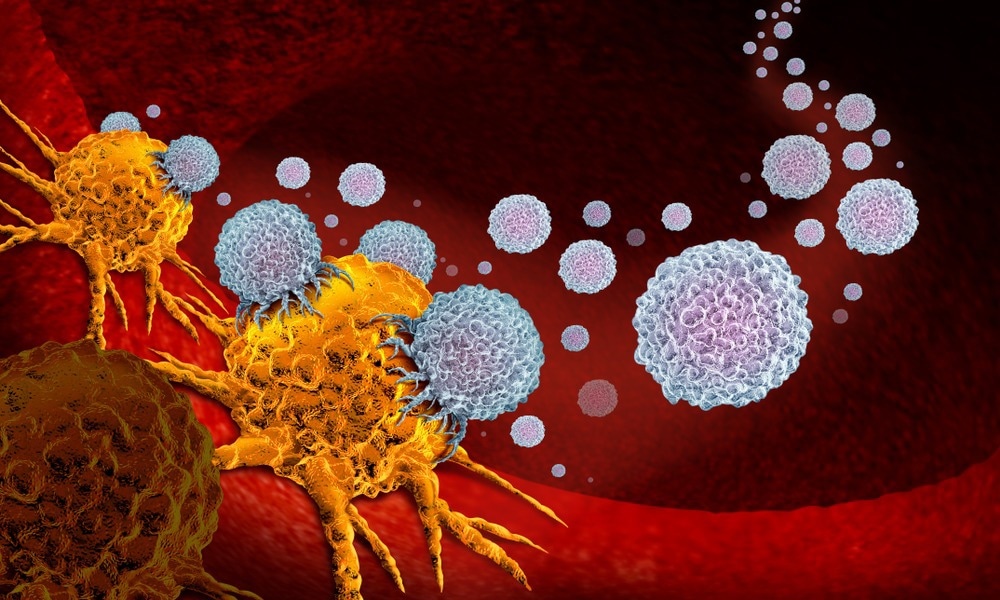Traditional methods to treat cancers pose the risk of causing damage to healthy tissue as they work to eradicate cancer cells. Scientists are currently investigating nanotechnology in cancer treatment to improve therapeutic efficacy.

Image Credit: Giovanni Cancemi/Shutterstock.com
How Can Nanotechnology Improve Cancer Therapy?
Nanotechnology in cancer treatment could enhance cancer therapy and reduces its adverse effects by guiding drugs to selectively target cancer cells. Nano-based cancer therapy could also guide the surgical resection of tumors with higher levels of accuracy and enhances the efficacy of radiotherapies and other cancer treatment options. The result is decreased risk to the patient and enhanced survival probabilities.
Researchers are developing novel cancer therapy options with newly discovered nanoparticles that have novel properties to be leveraged in medical science. While tiny in size, nanoparticles encapsulate small pharmaceutical compounds. The relatively large surface area of nanoparticles allows them to be decorated with ligands, strands of DNA and RNA, peptides, or antibodies. These ‘add-ons’ give the nanoparticle additional functionality that enhances the therapeutic effect or helps direct a nanoparticle to a specific location.
As a result, nanoparticles facilitate combination drug delivery, multi-modality treatment, and “theranostic,” action (combined therapeutic and diagnostic). The energy absorption and re-radiation properties of nanoparticles also allow them to improve laser ablation and hyperthermia applications, which disrupt diseased tissue.
Nanoparticle research in cancer therapy is currently progressing rapidly, such as the development of nanoparticle packages, active pharmaceutical ingredients to facilitate the exploration of a broader range of active ingredients, and the establishment of immunogenic cargo and surface coatings as adjuvants to nanoparticle-mediated therapy, radio- and chemotherapy, and stand-alone therapies.
Below, we discuss the major applications of nanotechnology in cancer treatment.
Nanotechnology in Cancer Treatment: Drug Delivery
The primary use of nanotechnology in cancer treatment is within the delivery of drugs. Much research has shown that nanotechnology has successfully been used to design multiple systems that improve the pharmacokinetics of a pharmaceutical drug and reduce the related toxicities.
These cancer therapy systems limit the adverse events of the drugs and augment a patient’s survival chances. They also allow chemotherapies to be more selective as they help deliver the drugs to the specific tumor tissues. These methods involve the development of nanocarriers that encompass and deliver the drug to its target.
There are numerous examples of these types of cancer therapy systems. One recent methodology has been used to increase the efficacy of chemotherapy drugs to treat bowel cancer. The results of clinical trials suggested that the nanoparticle delivery system could help increase survival rates of bowel cancer, the third most common cancer in the world, by helping the delivery of chemotherapy drugs directly to diseased organs.
In studies with animals, the system was proven to be effective at delivering Capecitabine (CAP) to the diseased cells while bypassing healthy cells. This reduced toxic side effects and enhanced the efficacy of tumor reduction activity.
Another example of nanotechnology in cancer treatment can be seen from recent research demonstrating the efficacy of nanoscale carriers in delivering alternative, herbal-based therapeutics. Scientists have created a novel targeted therapy to treat triple-negative breast cancer (TNBC) that utilizes nanocarriers to help deliver gambogic acid (GA), a Chinese medicine compound, to specific targets. Studies have shown that the novel methodology was effective at enhancing the anti-cancer effect of GA and limiting damage to healthy tissue. As a result, the use of GA may emerge as a more effective cancer therapy for treating TNBC.
In 2023, a team of researchers at Mount Sinai Health System and Memorial Sloan Kettering Cancer Center reported their novel nanoparticle-based drug delivery approach that facilitates more effective and targeted delivery of anticancer drugs to medulloblastoma cancer cells.
By leveraging drug-loaded fucoidan-based nanoparticles, the team demonstrated that they were able to transport the cancer treatment across the brain's blood-brain barrier (BBB) to deliver the drug to the specific site of the tumor, while sparing the healthy brain tissue.
The BBB has long presented a challenge to treating brain tumors due to its function in protecting the brain against invading entities. This nanotechnology innovation, therefore, will likely be significant in improving the treatment of brain tumors due to its ability to overcome this challenge, as well as showcasing the benefits of nanotechnology in cancer treatment.

Image Credit: Lightspring/Shutterstock.com
Nanotechnology in Cancer Treatment: Enhancing Immunotherapy
Another encouraging area of nanotechnology in cancer treatment is its use in enhancing immunotherapy. While immunotherapy has already been established as an exciting and potentially highly effective cancer therapy option for various types of cancer, the proportion of patients who respond positively to immunotherapy remains low, with only around 15% of patients demonstrating an objective response rate across indications. This is linked to the multiple immune-evasion methods of the tumor.
To help boost the immune system’s efficacy against cancer, nanotechnology is being leveraged to manage the spatiotemporal control of the immune system. The idea is that naturally, the immune system is spatiotemporally controlled. Therefore, to work effectively, therapies that impact the immune system should also be spatiotemporally controlled.
Recent research has demonstrated that nanoparticles and biomaterials allow scientists to control the delivery, pharmacokinetics, and location of immunomodulatory compounds, generating responses that cannot be elevated by administering the same compounds within a solution.
A recent advancement from scientists at the University of Michigan College of Pharmacy and the Rogel Cancer Center may help overcome the challenge of low tumor response rates in immunotherapy. Previous research has shown that “cold tumors” – those that do not trigger a strong immune response, do not respond well to one of the most common forms of cancer immunotherapy, immune checkpoint inhibitors.
To turn these “cold” tumors into “hot” tumors, thus switching on the body’s own immune system, the team developed a new, self-assembling nanoparticle made ofcyclic dinucleotide (CDN) stimulator of interferon genes (STING) agonists and Mn2+. The nanoparticle was successful in triggering STING activation, turning a “cold” tumor into “hot" tumor. By converting “cold” tumors to “hot” tumors, the team succeeded in making the tumors sensitive to immune checkpoint inhibitor-based cancer therapy.
Nanotechnology in Cancer Treatment: Radiotherapy
Radiotherapy is administered to around half of patients with cancer at some point during their treatment. Radiotherapy is an effective cancer therapy as it reduces the size of tumors by exposing them to high-energy radiation. However, this radiation can also damage healthy cells.
Scientists have been working on enhancing the effect of radiotherapy, as well as developing novel externally applied electromagnetic radiation. As a result, it is possible that nanotechnology in cancer treatments like radiotherapy may produce more effective results than radiotherapy alone.
In addition, recent research has reported how a novel nanoparticle could be used in cancer therapy to protect those at risk of bone damage from radiotherapy. The cerium oxide nanoparticle was developed by a team at Oakland University, North Carolina A&T University, the University of Sheffield and University of Huddersfield. Their initial rodent studies showed that the nanoparticle could be used to protect against the weakening and damaging impact on the bones of radiation exposure.
Given that there is currently no real drug or therapy to protect patients from these effects, the novel nanoparticle has the potential to significantly enhance the outcomes of cancer therapy with radiation.
How nanoparticles could change the way we treat cancer | Joy Wolfram
Video Credit: TED/YouTube.com
This article was updated June 2023.
References and Further Reading
Christian Senior. (2021). UCF Researchers Design Treatment to Protect Bones During Cancer Therapy [online]. University of Central Florida. Available at: https://www.ucf.edu/news/ucf-researchers-design-treatment-to-protect-bones-during-cancer-therapy/
HKBU and Cornell University develop novel targeted therapy for breast cancer with nanotechnology and Chinese medicine. EurekAlert!. Available at: https://www.eurekalert.org/pub_releases/2021-05/hkbu-hac051121.php
Goldberg, M., 2019. Improving cancer immunotherapy through nanotechnology. Nature Reviews Cancer, 19(10), pp.587-602. https://www.nature.com/articles/s41568-019-0186-9
Sun, X. et al. (2021) “Amplifying sting activation by cyclic dinucleotide–manganese particles for local and systemic cancer metalloimmunotherapy,” Nature Nanotechnology, 16(11), pp. 1260–1270. Available at: https://doi.org/10.1038/s41565-021-00962-9.
Targeting Bowel Cancer with Nanotechnology. GEN. Available at: https://www.genengnews.com/topics/targeting-bowel-cancer-with-nanotechnology/
Tylawsky, D.E. et al. (2023) “P-selectin-targeted nanocarriers induce active crossing of the blood–brain barrier via caveolin-1-dependent transcytosis,” Nature Materials, 22(3), pp. 391–399. Available at: https://doi.org/10.1038/s41563-023-01481-9.
van der Meel, R., Sulheim, E., Shi, Y., Kiessling, F., Mulder, W. and Lammers, T., 2019. Smart cancer nanomedicine. Nature Nanotechnology, 14(11), pp.1007-1017. https://www.nature.com/articles/s41565-019-0567-y
Disclaimer: The views expressed here are those of the author expressed in their private capacity and do not necessarily represent the views of AZoM.com Limited T/A AZoNetwork the owner and operator of this website. This disclaimer forms part of the Terms and conditions of use of this website.